David's Astronomy Pages
Notes - Session 1158 (2023-10-22)
Notes
(S1157)
Notes
Main
Home
Page
Notes
(S1159)
David's Astronomy Pages
|
Notes (S1157) |
Notes Main |
Home Page |
Notes (S1159) |
Main aims
Equipment & Software
Highlights

Summary Plots & Logs
Observing Plan |
||||||||||||||||||||||||||||||||||||||||||||||||||||||||||||||||||||||||||||||||||||||||||||||||||||||||||||||||||||||||||||||||||||||||||||||||||||||||||||||||||||||||||||||||||||||||||||||||||||||||||||||||||||||||||||||||||||||||||||||||||||||||||||||||||||||||||||||||||||||||||||||||||||||||||||||||||||||||||||||||||||||||||||||||||||||||||||||||||||||||||||||||||||||||||||||||||||||||||||||||||||||||||||||||||||||||||||||||||||||||||||||||||||||||||||||||||||||||||||||||||||||||||||||||||||||||||||||||||||||||||||||||||||||||||||||||||||||||||||||||||||||||||||||||||||||||||||||||||||||||||||||||||||||||||||||||||||||||||||||||||||||||||||||||||||||||||||||||||||||||||||||||||||||||||||||||||||||||||||||||||||||||||||||||||||||||||||
|
Observing Result |
||||||||||||||||||||||||||||||||||||||||||||||||||||||||||||||||||||||||||||||||||||||||||||||||||||||||||||||||||||||||||||||||||||||||||||||||||||||||||||||||||||||||||||||||||||||||||||||||||||||||||||||||||||||||||||||||||||||||||||||||||||||||||||||||||||||||||||||||||||||||||||||||||||||||||||||||||||||||||||||||||||||||||||||||||||||||||||||||||||||||||||||||||||||||||||||||||||||||||||||||||||||||||||||||||||||||||||||||||||||||||||||||||||||||||||||||||||||||||||||||||||||||||||||||||||||||||||||||||||||||||||||||||||||||||||||||||||||||||||||||||||||||||||||||||||||||||||||||||||||||||||||||||||||||||||||||||||||||||||||||||||||||||||||||||||||||||||||||||||||||||||||||||||||||||||||||||||||||||||||||||||||||||||||||||||||||||||
 |
||||||||||||||||||||||||||||||||||||||||||||||||||||||||||||||||||||||||||||||||||||||||||||||||||||||||||||||||||||||||||||||||||||||||||||||||||||||||||||||||||||||||||||||||||||||||||||||||||||||||||||||||||||||||||||||||||||||||||||||||||||||||||||||||||||||||||||||||||||||||||||||||||||||||||||||||||||||||||||||||||||||||||||||||||||||||||||||||||||||||||||||||||||||||||||||||||||||||||||||||||||||||||||||||||||||||||||||||||||||||||||||||||||||||||||||||||||||||||||||||||||||||||||||||||||||||||||||||||||||||||||||||||||||||||||||||||||||||||||||||||||||||||||||||||||||||||||||||||||||||||||||||||||||||||||||||||||||||||||||||||||||||||||||||||||||||||||||||||||||||||||||||||||||||||||||||||||||||||||||||||||||||||||||||||||||||||||
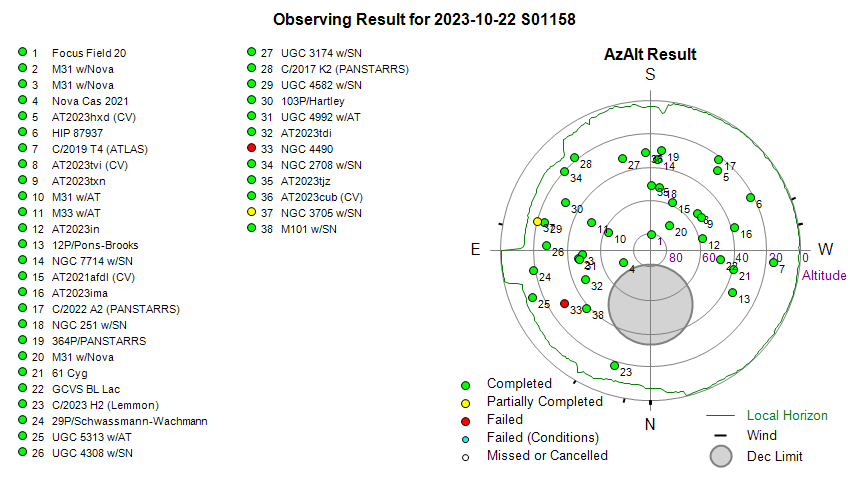 |
||||||||||||||||||||||||||||||||||||||||||||||||||||||||||||||||||||||||||||||||||||||||||||||||||||||||||||||||||||||||||||||||||||||||||||||||||||||||||||||||||||||||||||||||||||||||||||||||||||||||||||||||||||||||||||||||||||||||||||||||||||||||||||||||||||||||||||||||||||||||||||||||||||||||||||||||||||||||||||||||||||||||||||||||||||||||||||||||||||||||||||||||||||||||||||||||||||||||||||||||||||||||||||||||||||||||||||||||||||||||||||||||||||||||||||||||||||||||||||||||||||||||||||||||||||||||||||||||||||||||||||||||||||||||||||||||||||||||||||||||||||||||||||||||||||||||||||||||||||||||||||||||||||||||||||||||||||||||||||||||||||||||||||||||||||||||||||||||||||||||||||||||||||||||||||||||||||||||||||||||||||||||||||||||||||||||||||
| Dome & Scope Slewing Performance | ||||||||||||||||||||||||||||||||||||||||||||||||||||||||||||||||||||||||||||||||||||||||||||||||||||||||||||||||||||||||||||||||||||||||||||||||||||||||||||||||||||||||||||||||||||||||||||||||||||||||||||||||||||||||||||||||||||||||||||||||||||||||||||||||||||||||||||||||||||||||||||||||||||||||||||||||||||||||||||||||||||||||||||||||||||||||||||||||||||||||||||||||||||||||||||||||||||||||||||||||||||||||||||||||||||||||||||||||||||||||||||||||||||||||||||||||||||||||||||||||||||||||||||||||||||||||||||||||||||||||||||||||||||||||||||||||||||||||||||||||||||||||||||||||||||||||||||||||||||||||||||||||||||||||||||||||||||||||||||||||||||||||||||||||||||||||||||||||||||||||||||||||||||||||||||||||||||||||||||||||||||||||||||||||||||||||||||
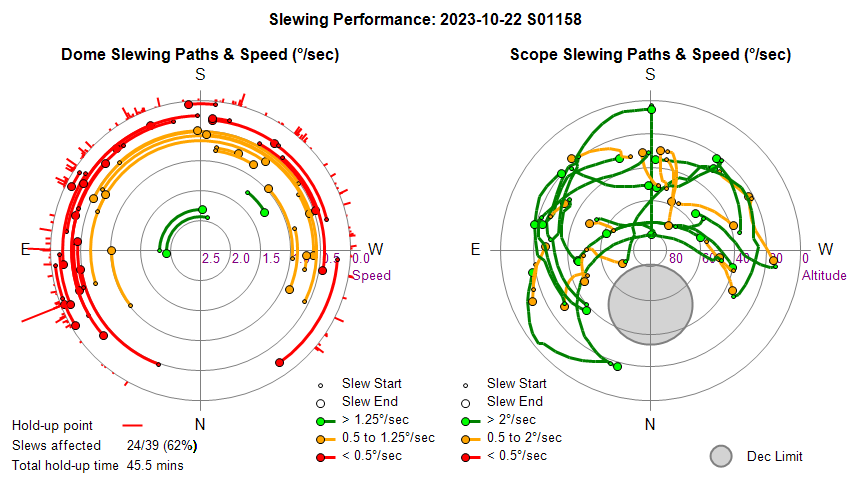 |
||||||||||||||||||||||||||||||||||||||||||||||||||||||||||||||||||||||||||||||||||||||||||||||||||||||||||||||||||||||||||||||||||||||||||||||||||||||||||||||||||||||||||||||||||||||||||||||||||||||||||||||||||||||||||||||||||||||||||||||||||||||||||||||||||||||||||||||||||||||||||||||||||||||||||||||||||||||||||||||||||||||||||||||||||||||||||||||||||||||||||||||||||||||||||||||||||||||||||||||||||||||||||||||||||||||||||||||||||||||||||||||||||||||||||||||||||||||||||||||||||||||||||||||||||||||||||||||||||||||||||||||||||||||||||||||||||||||||||||||||||||||||||||||||||||||||||||||||||||||||||||||||||||||||||||||||||||||||||||||||||||||||||||||||||||||||||||||||||||||||||||||||||||||||||||||||||||||||||||||||||||||||||||||||||||||||||||
| Slew/Centering Performance | ||||||||||||||||||||||||||||||||||||||||||||||||||||||||||||||||||||||||||||||||||||||||||||||||||||||||||||||||||||||||||||||||||||||||||||||||||||||||||||||||||||||||||||||||||||||||||||||||||||||||||||||||||||||||||||||||||||||||||||||||||||||||||||||||||||||||||||||||||||||||||||||||||||||||||||||||||||||||||||||||||||||||||||||||||||||||||||||||||||||||||||||||||||||||||||||||||||||||||||||||||||||||||||||||||||||||||||||||||||||||||||||||||||||||||||||||||||||||||||||||||||||||||||||||||||||||||||||||||||||||||||||||||||||||||||||||||||||||||||||||||||||||||||||||||||||||||||||||||||||||||||||||||||||||||||||||||||||||||||||||||||||||||||||||||||||||||||||||||||||||||||||||||||||||||||||||||||||||||||||||||||||||||||||||||||||||||||
 |
||||||||||||||||||||||||||||||||||||||||||||||||||||||||||||||||||||||||||||||||||||||||||||||||||||||||||||||||||||||||||||||||||||||||||||||||||||||||||||||||||||||||||||||||||||||||||||||||||||||||||||||||||||||||||||||||||||||||||||||||||||||||||||||||||||||||||||||||||||||||||||||||||||||||||||||||||||||||||||||||||||||||||||||||||||||||||||||||||||||||||||||||||||||||||||||||||||||||||||||||||||||||||||||||||||||||||||||||||||||||||||||||||||||||||||||||||||||||||||||||||||||||||||||||||||||||||||||||||||||||||||||||||||||||||||||||||||||||||||||||||||||||||||||||||||||||||||||||||||||||||||||||||||||||||||||||||||||||||||||||||||||||||||||||||||||||||||||||||||||||||||||||||||||||||||||||||||||||||||||||||||||||||||||||||||||||||||
| Guiding Performance | ||||||||||||||||||||||||||||||||||||||||||||||||||||||||||||||||||||||||||||||||||||||||||||||||||||||||||||||||||||||||||||||||||||||||||||||||||||||||||||||||||||||||||||||||||||||||||||||||||||||||||||||||||||||||||||||||||||||||||||||||||||||||||||||||||||||||||||||||||||||||||||||||||||||||||||||||||||||||||||||||||||||||||||||||||||||||||||||||||||||||||||||||||||||||||||||||||||||||||||||||||||||||||||||||||||||||||||||||||||||||||||||||||||||||||||||||||||||||||||||||||||||||||||||||||||||||||||||||||||||||||||||||||||||||||||||||||||||||||||||||||||||||||||||||||||||||||||||||||||||||||||||||||||||||||||||||||||||||||||||||||||||||||||||||||||||||||||||||||||||||||||||||||||||||||||||||||||||||||||||||||||||||||||||||||||||||||||
 |
||||||||||||||||||||||||||||||||||||||||||||||||||||||||||||||||||||||||||||||||||||||||||||||||||||||||||||||||||||||||||||||||||||||||||||||||||||||||||||||||||||||||||||||||||||||||||||||||||||||||||||||||||||||||||||||||||||||||||||||||||||||||||||||||||||||||||||||||||||||||||||||||||||||||||||||||||||||||||||||||||||||||||||||||||||||||||||||||||||||||||||||||||||||||||||||||||||||||||||||||||||||||||||||||||||||||||||||||||||||||||||||||||||||||||||||||||||||||||||||||||||||||||||||||||||||||||||||||||||||||||||||||||||||||||||||||||||||||||||||||||||||||||||||||||||||||||||||||||||||||||||||||||||||||||||||||||||||||||||||||||||||||||||||||||||||||||||||||||||||||||||||||||||||||||||||||||||||||||||||||||||||||||||||||||||||||||||
| Sky Conditions (Locate Frames) | ||||||||||||||||||||||||||||||||||||||||||||||||||||||||||||||||||||||||||||||||||||||||||||||||||||||||||||||||||||||||||||||||||||||||||||||||||||||||||||||||||||||||||||||||||||||||||||||||||||||||||||||||||||||||||||||||||||||||||||||||||||||||||||||||||||||||||||||||||||||||||||||||||||||||||||||||||||||||||||||||||||||||||||||||||||||||||||||||||||||||||||||||||||||||||||||||||||||||||||||||||||||||||||||||||||||||||||||||||||||||||||||||||||||||||||||||||||||||||||||||||||||||||||||||||||||||||||||||||||||||||||||||||||||||||||||||||||||||||||||||||||||||||||||||||||||||||||||||||||||||||||||||||||||||||||||||||||||||||||||||||||||||||||||||||||||||||||||||||||||||||||||||||||||||||||||||||||||||||||||||||||||||||||||||||||||||||||
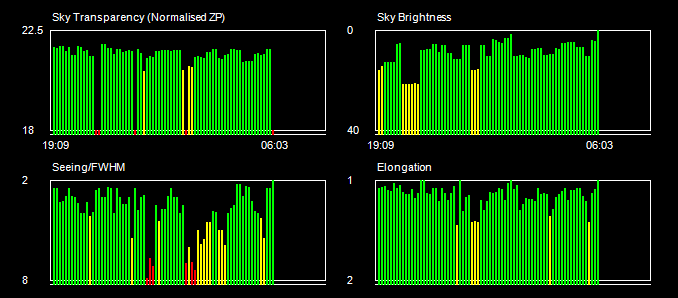 |
||||||||||||||||||||||||||||||||||||||||||||||||||||||||||||||||||||||||||||||||||||||||||||||||||||||||||||||||||||||||||||||||||||||||||||||||||||||||||||||||||||||||||||||||||||||||||||||||||||||||||||||||||||||||||||||||||||||||||||||||||||||||||||||||||||||||||||||||||||||||||||||||||||||||||||||||||||||||||||||||||||||||||||||||||||||||||||||||||||||||||||||||||||||||||||||||||||||||||||||||||||||||||||||||||||||||||||||||||||||||||||||||||||||||||||||||||||||||||||||||||||||||||||||||||||||||||||||||||||||||||||||||||||||||||||||||||||||||||||||||||||||||||||||||||||||||||||||||||||||||||||||||||||||||||||||||||||||||||||||||||||||||||||||||||||||||||||||||||||||||||||||||||||||||||||||||||||||||||||||||||||||||||||||||||||||||||||
|
Night Sky Summary Plot Top axis: Sky Brightness at Zenith (in ADU/s) Lefthand axis: Local Time (hh LT). Righthand axis: Sun Altitude (degs) |
||||||||||||||||||||||||||||||||||||||||||||||||||||||||||||||||||||||||||||||||||||||||||||||||||||||||||||||||||||||||||||||||||||||||||||||||||||||||||||||||||||||||||||||||||||||||||||||||||||||||||||||||||||||||||||||||||||||||||||||||||||||||||||||||||||||||||||||||||||||||||||||||||||||||||||||||||||||||||||||||||||||||||||||||||||||||||||||||||||||||||||||||||||||||||||||||||||||||||||||||||||||||||||||||||||||||||||||||||||||||||||||||||||||||||||||||||||||||||||||||||||||||||||||||||||||||||||||||||||||||||||||||||||||||||||||||||||||||||||||||||||||||||||||||||||||||||||||||||||||||||||||||||||||||||||||||||||||||||||||||||||||||||||||||||||||||||||||||||||||||||||||||||||||||||||||||||||||||||||||||||||||||||||||||||||||||||||
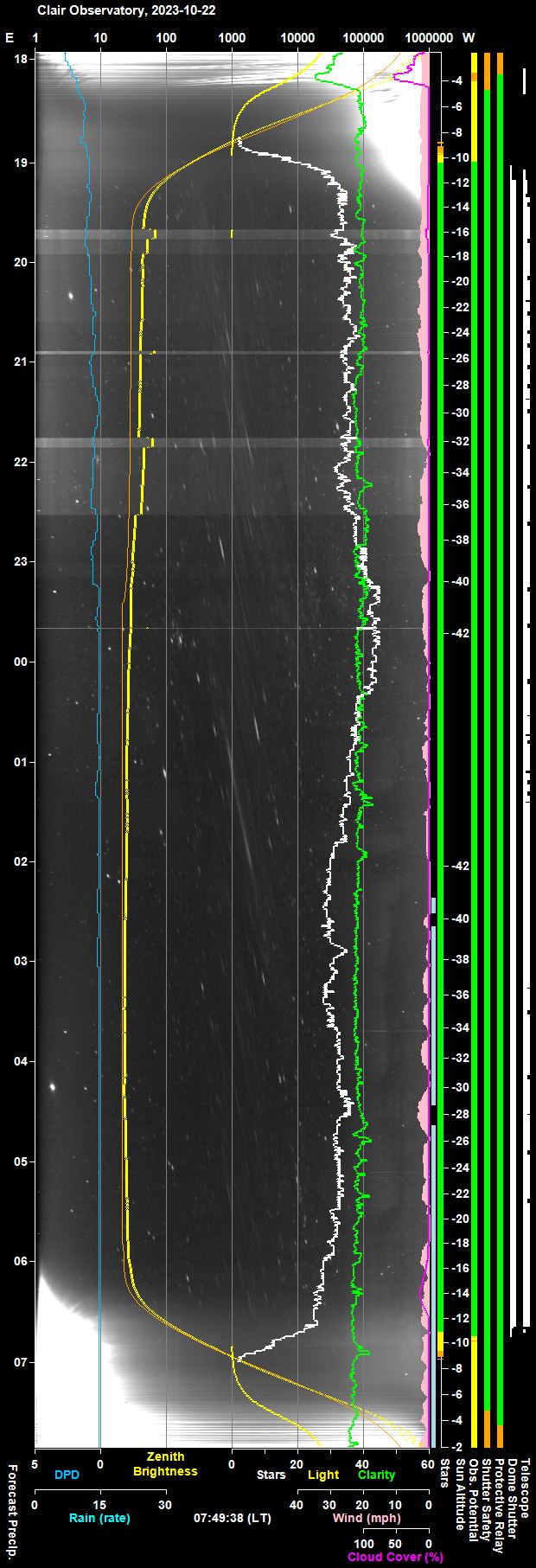 |
||||||||||||||||||||||||||||||||||||||||||||||||||||||||||||||||||||||||||||||||||||||||||||||||||||||||||||||||||||||||||||||||||||||||||||||||||||||||||||||||||||||||||||||||||||||||||||||||||||||||||||||||||||||||||||||||||||||||||||||||||||||||||||||||||||||||||||||||||||||||||||||||||||||||||||||||||||||||||||||||||||||||||||||||||||||||||||||||||||||||||||||||||||||||||||||||||||||||||||||||||||||||||||||||||||||||||||||||||||||||||||||||||||||||||||||||||||||||||||||||||||||||||||||||||||||||||||||||||||||||||||||||||||||||||||||||||||||||||||||||||||||||||||||||||||||||||||||||||||||||||||||||||||||||||||||||||||||||||||||||||||||||||||||||||||||||||||||||||||||||||||||||||||||||||||||||||||||||||||||||||||||||||||||||||||||||||||
| Actual Weather vs Pre-Session Weather Forecast | ||||||||||||||||||||||||||||||||||||||||||||||||||||||||||||||||||||||||||||||||||||||||||||||||||||||||||||||||||||||||||||||||||||||||||||||||||||||||||||||||||||||||||||||||||||||||||||||||||||||||||||||||||||||||||||||||||||||||||||||||||||||||||||||||||||||||||||||||||||||||||||||||||||||||||||||||||||||||||||||||||||||||||||||||||||||||||||||||||||||||||||||||||||||||||||||||||||||||||||||||||||||||||||||||||||||||||||||||||||||||||||||||||||||||||||||||||||||||||||||||||||||||||||||||||||||||||||||||||||||||||||||||||||||||||||||||||||||||||||||||||||||||||||||||||||||||||||||||||||||||||||||||||||||||||||||||||||||||||||||||||||||||||||||||||||||||||||||||||||||||||||||||||||||||||||||||||||||||||||||||||||||||||||||||||||||||||||
 |
||||||||||||||||||||||||||||||||||||||||||||||||||||||||||||||||||||||||||||||||||||||||||||||||||||||||||||||||||||||||||||||||||||||||||||||||||||||||||||||||||||||||||||||||||||||||||||||||||||||||||||||||||||||||||||||||||||||||||||||||||||||||||||||||||||||||||||||||||||||||||||||||||||||||||||||||||||||||||||||||||||||||||||||||||||||||||||||||||||||||||||||||||||||||||||||||||||||||||||||||||||||||||||||||||||||||||||||||||||||||||||||||||||||||||||||||||||||||||||||||||||||||||||||||||||||||||||||||||||||||||||||||||||||||||||||||||||||||||||||||||||||||||||||||||||||||||||||||||||||||||||||||||||||||||||||||||||||||||||||||||||||||||||||||||||||||||||||||||||||||||||||||||||||||||||||||||||||||||||||||||||||||||||||||||||||||||||
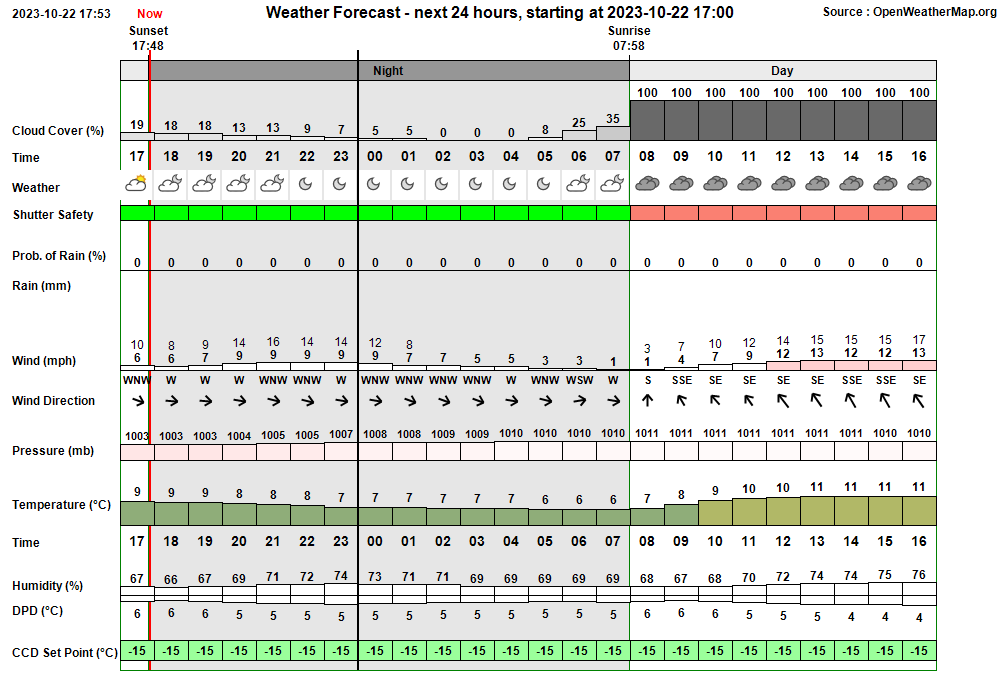 |
||||||||||||||||||||||||||||||||||||||||||||||||||||||||||||||||||||||||||||||||||||||||||||||||||||||||||||||||||||||||||||||||||||||||||||||||||||||||||||||||||||||||||||||||||||||||||||||||||||||||||||||||||||||||||||||||||||||||||||||||||||||||||||||||||||||||||||||||||||||||||||||||||||||||||||||||||||||||||||||||||||||||||||||||||||||||||||||||||||||||||||||||||||||||||||||||||||||||||||||||||||||||||||||||||||||||||||||||||||||||||||||||||||||||||||||||||||||||||||||||||||||||||||||||||||||||||||||||||||||||||||||||||||||||||||||||||||||||||||||||||||||||||||||||||||||||||||||||||||||||||||||||||||||||||||||||||||||||||||||||||||||||||||||||||||||||||||||||||||||||||||||||||||||||||||||||||||||||||||||||||||||||||||||||||||||||||||
| Session Event Log | ||||||||||||||||||||||||||||||||||||||||||||||||||||||||||||||||||||||||||||||||||||||||||||||||||||||||||||||||||||||||||||||||||||||||||||||||||||||||||||||||||||||||||||||||||||||||||||||||||||||||||||||||||||||||||||||||||||||||||||||||||||||||||||||||||||||||||||||||||||||||||||||||||||||||||||||||||||||||||||||||||||||||||||||||||||||||||||||||||||||||||||||||||||||||||||||||||||||||||||||||||||||||||||||||||||||||||||||||||||||||||||||||||||||||||||||||||||||||||||||||||||||||||||||||||||||||||||||||||||||||||||||||||||||||||||||||||||||||||||||||||||||||||||||||||||||||||||||||||||||||||||||||||||||||||||||||||||||||||||||||||||||||||||||||||||||||||||||||||||||||||||||||||||||||||||||||||||||||||||||||||||||||||||||||||||||||||||
|
||||||||||||||||||||||||||||||||||||||||||||||||||||||||||||||||||||||||||||||||||||||||||||||||||||||||||||||||||||||||||||||||||||||||||||||||||||||||||||||||||||||||||||||||||||||||||||||||||||||||||||||||||||||||||||||||||||||||||||||||||||||||||||||||||||||||||||||||||||||||||||||||||||||||||||||||||||||||||||||||||||||||||||||||||||||||||||||||||||||||||||||||||||||||||||||||||||||||||||||||||||||||||||||||||||||||||||||||||||||||||||||||||||||||||||||||||||||||||||||||||||||||||||||||||||||||||||||||||||||||||||||||||||||||||||||||||||||||||||||||||||||||||||||||||||||||||||||||||||||||||||||||||||||||||||||||||||||||||||||||||||||||||||||||||||||||||||||||||||||||||||||||||||||||||||||||||||||||||||||||||||||||||||||||||||||||||||
| Session Alerts & Alarms | ||||||||||||||||||||||||||||||||||||||||||||||||||||||||||||||||||||||||||||||||||||||||||||||||||||||||||||||||||||||||||||||||||||||||||||||||||||||||||||||||||||||||||||||||||||||||||||||||||||||||||||||||||||||||||||||||||||||||||||||||||||||||||||||||||||||||||||||||||||||||||||||||||||||||||||||||||||||||||||||||||||||||||||||||||||||||||||||||||||||||||||||||||||||||||||||||||||||||||||||||||||||||||||||||||||||||||||||||||||||||||||||||||||||||||||||||||||||||||||||||||||||||||||||||||||||||||||||||||||||||||||||||||||||||||||||||||||||||||||||||||||||||||||||||||||||||||||||||||||||||||||||||||||||||||||||||||||||||||||||||||||||||||||||||||||||||||||||||||||||||||||||||||||||||||||||||||||||||||||||||||||||||||||||||||||||||||||
|
||||||||||||||||||||||||||||||||||||||||||||||||||||||||||||||||||||||||||||||||||||||||||||||||||||||||||||||||||||||||||||||||||||||||||||||||||||||||||||||||||||||||||||||||||||||||||||||||||||||||||||||||||||||||||||||||||||||||||||||||||||||||||||||||||||||||||||||||||||||||||||||||||||||||||||||||||||||||||||||||||||||||||||||||||||||||||||||||||||||||||||||||||||||||||||||||||||||||||||||||||||||||||||||||||||||||||||||||||||||||||||||||||||||||||||||||||||||||||||||||||||||||||||||||||||||||||||||||||||||||||||||||||||||||||||||||||||||||||||||||||||||||||||||||||||||||||||||||||||||||||||||||||||||||||||||||||||||||||||||||||||||||||||||||||||||||||||||||||||||||||||||||||||||||||||||||||||||||||||||||||||||||||||||||||||||||||||
Back to Top
writer.WriteLine ("if exist " + """" + DestFile1(3) + """" + "
("
writer.WriteLine(" copy " + "/Y " + """" +
DestFile1(3) + """" + " " + """" + DestFile3_detail + """")
writer.WriteLine (")"Fig 1. Dome Relay Settings in Pulsar Dome Settings (from screen capture 2023-10-28)
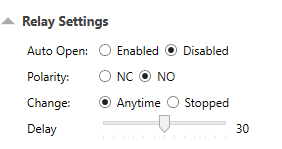
Note that
'Polarity' is set to the 'NO' option for it to get the replay state intended
by the observatory's CloudSensor.
Back to Top
'Replay Dome Slews' is a new capability of the Observatory's
AstroMain Program, which replays the Dome Slews conducted during the last or
other previous session and compares dome slewing performance with the
performance seen during the actual live session.
Background
An ongoing issue is that some sessions experience poor dome slewing
performance whereby up to 30-35% of slews experience a significant hold-up
during the course of the slew amount to 20-120s ( and occasionally up to
150-180s). During the hold-up the rotation drive wheels spin on the roof flange
and don't generate rotation of the dome roof until some point where they gain
sufficient friction to begin rotating the dome again. The amount of
total time lost can sometimes reach 15-18 minutes in a session.
In
other sessions (on other nights) the dome slewing performance is good with no
significant hold-ups at all.
The are several factors at play here.
-
Observatory walls form a non-perfect circle which varies the effort needed to
move the dome at differing points.
- Deformations in the roof flange (caused)
by the force of wheels acting on the certain section of the roof flange (made
worse by the wall's non-perfect circle shape)
- Amount of force that dome
rotation wheels (2 wheels on one side of the flange, 1 wheel on the other) can
apply to the dome's roof fange, controlled by tension adjusters.
- Amount of
condensation/dew formed on the roof flange (both internal & externally facing)
and the amount of dampness collected on the dome's rotation drive wheels.
Increasingly 'condensation/dew' is the factor that is believed to be
the most significant in terms of whether a session will or will not experience
significant hold-up.
New Capability - Replay Dome Slews
In order to assess the
impact of condensation/dew in particular a new button and thread routine have
been written and added to AstroMain 3.16.2 on 2023-10-21 .
After the user
selects a session to 'replay', the 'Replay Dome Slews' will read key information
about actual dome slew made during the previous session from that session's
'(slewtable).dat' file and directs the dome to make the precise same
series of movements that the dome made during the live session, and compares
dome slewing times, speeds and hold-ups (if any) with the equivalent numbers
from the live session.
Testing
After first testing
using dome simulators on Development Computer the new version of AstroMain
(3.63.2) was installed on the Observatory after which the dome slews from the
previous session (2023-10-16 S1157) were successfully replayed on the morning of
2023-10-22.
Replay was conducted after wiping / drying the roof flange
and indirectly also drying the dome's rotation drive wheels. An initial
attempt to move the dome failedas the rotation wheels where spinning of the same
spot for 2+ minutes. This prompted the action to wipe / dry the rotation
system.
Report messages generated during the course of the playback are shown below:
For each slew the details of the slew from live session are given.
These are the Start and End Points for the slew (Az1 and Az2) , the Slew
time, the Angle traversed, Speed and Hold-Up details (if any),. The
slew from Az1 to Az2 is replayed and Slew time, Speed and Hold-Up details
(if any) are then presented, for the user to compare
Replay Dome Slews 2023-10-22 11:18 (Local, BST)
Source Session Ok 2023-10-16 S01157
Source Slews Table Ok 2023-10-16 S01157 Observatory (slewtable).dat
Replay slew to Focus Field 5 2023-10-22 11:18 (Local, BST)
|Target Time Az1 Az2 Slew Angle Speed Holdup Dome Holdup Az
| hh:mm deg deg time deg deg/s time degs
|Focus Field 5 04:31 90.1 179.8 89s 89.7 1.00 10s
Preparing for slew 1 Ok Dome at Az1 90.1°
Making slew Ok Dome at Az2 179.8° 48s 89.7 1.9
Replay slew to Nova Cas 2021 2023-10-22 11:19 (Local, BST)
|Nova Cas 2021 04:42 187.1 310.5 130s 123.4 0.95 D* 34s
Preparing for slew 2 Ok Dome at Az1 187.1°
Making slew Ok Dome at Az2 310.5° 60s 123.4 2.1
Replay slew to M31 2023-10-22 11:21 (Local, BST)
|M31 05:02 312.7 280.3 32s 32.4 1.01 5s
Preparing for slew 3 Ok Dome at Az1 312.7°
Making slew Ok Dome at Az2 280.3° 30s 32.4 1.1 7s 308.5
Replay slew to 103P/Hartley 2023-10-22 11:21 (Local, BST)
|103P/Hartley 05:25 283.7 143.8 176s 139.9 0.79 D* 60s 264.3, 247.4, 223.0, 222.4, 189.4, 144.2
Preparing for slew 4 Ok Dome at Az1 283.7°
Making slew Ok Dome at Az2 143.8° 70s 139.9 2.0
Replay slew to NGC 2708 2023-10-22 11:23 (Local, BST)
|NGC 2708 05:41 148.3 137.5 10s 10.8 1.14
Preparing for slew 5 Ok Dome at Az1 148.3°
Making slew Ok Dome at Az2 137.5° 8s 10.8 1.3
Replay slew to AT2023cub 2023-10-22 11:23 (Local, BST)
|AT2023cub 06:01 142.1 174.1 33s 32.0 0.98 D* 6s
Preparing for slew 6 Ok Dome at Az1 142.1°
Making slew Ok Dome at Az2 174.1° 20s 32.0 1.6
Replay slew to GCVS SY Cnc 2023-10-22 11:23 (Local, BST)
|GCVS SY Cnc 06:12 176.3 135.4 80s 40.9 0.51 D* 43s
Preparing for slew 7 Ok Dome at Az1 176.3°
Making slew Ok Dome at Az2 135.4° 26s 40.9 1.6
Replay slew to Pre-Park 2023-10-22 11:24 (Local, BST)
|Pre-Park 06:22 136.6 90.1 57s 46.5 0.81 D* 13s
Preparing for slew 8 Ok Dome at Az1 136.6°
Making slew Ok Dome at Az2 90.1° 28s 46.5 1.7
During the actual S1157 live session
- 7
slews were recorded to have a hold-up of which 3
were significant with holds-ups of 34, 43 and 60s total duration.
- Total hold-up time across all slews was 2.9 minutes.
During the
replay (conducted in daytime hours after drying the roof flange and rotation
drive wheels)
- Only 1 slew recorded any hold-up (and it was of only 7s
duration).
- Total hold-up time across all slews was 0.1 minute.
Slewing performance was clearly a lot better during the Replay than
during the live session. The difference is considered to be due to the
difference in the friction between drive motor wheels and the roof flange
(with the friction being significantly higher during the Play followin the
drying off of the roof flange & motor drive wheels).
For full
disclosure it should be noted that actual dome slews were made with an open Dome Shutter,
whilst the
replay slews were made with a closed Dome Shutter. The impact of different
roof weight distributions (open vs close shutter) on slew hold-ups is
unknown at this stage.
Actions
Back to Top
Issue: Certain sessions (such as S1158 session, 2023-10-22) experience significant hold-ups during Dome Slewing. This lengthens the overall slew time, delaying the start of target imaging and potentially delaying the following targets. In the S1158 session 62% of slews had significant hold-ups, and the total time lost to hold-ups was 45 minutes.
Background
Poor slewing performance from the observatory's Pulsar Dome had
been a regular issue with dome slews to new azimuth positions being prone to
hold-ups during slewing :
The issue was first described and briefly investigated in Sep 2019 (see Investigation - Dome Drive Slippage, Slow Slewing & Park Dome Failure, 2019-09-01) . The issue has been logged as a "Major Issue" in 5 out of 20 sessions conducted since beginning of Sep 2023 (S1158, S1156, S1154, S1145, S1143).
The impact of lost time on the scheduled acquisition of targets in a session due to hold-ups is presently mitigated by an increase in the timing tolerance allowed for each target in the observing plan. Provided that centering operations proceed well (good sky / plenty of stars to link), the time lost to dome hold-ups can be accomodated within each scheduled target's time slot. If the dome slewing issue can be resolved the timing tolerance can be reduced which would allow more targets to be acquired and imaged in a night. For the S1158 session where 45 minutes were lost in total due to hold-ups this time could have been used to acquire 2 extra targets acquiring 5 x 180s main frames or 3 or 4 extra targets acquiring 3 x 60s main frames.
The following two charts show examples of good slewing performance in Feb-Apr 2023, with session S1101 (2023-02-22) where none of its 32 dome slews suffered from any significant hold-up. Similary in the S1110 session (2023-04-02) there were no significant hold-ups. (Green arcs in Charts are good (normal), Orange arcs are less good, but generally still tolerable). , Red arcs are bad (poor slew perfomance), with red spoke lines (if any, indicating azimuths with hold-ups)

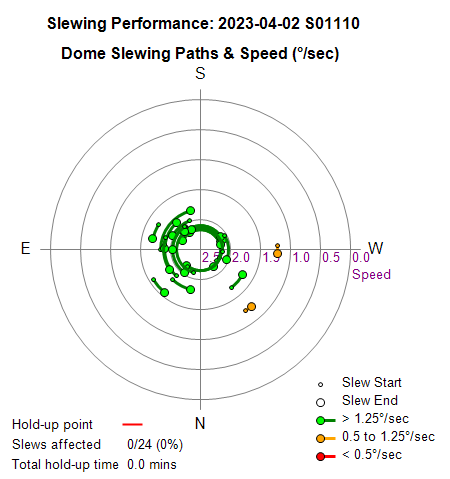
The issue was noted to have became progressively worse during sessions in late Apr - Jul 2023, such that in session S1122 (2023-07-15) nearly every single slew suffered a significant hold-up and a total of 22.7 minutes were lost during the session because of this problem (this is particularly significant given the very short observing period associated with a short summer night).
The two charts below show the bad dome slewing performance from sessions S1121 (2023-06-07) & S1122 (2023-07-15) in which the majority of slews suffered from significant hold-ups. (Green arcs in the Charts indicate good (normal) performance, Orange arcs indicate less good performance, but generally still tolerable, Red arcs indicate bad performance. The red spoke lines indicate the azimuth positions where a hold-up occured, with its line-length indicating the duration of the hold-up. )
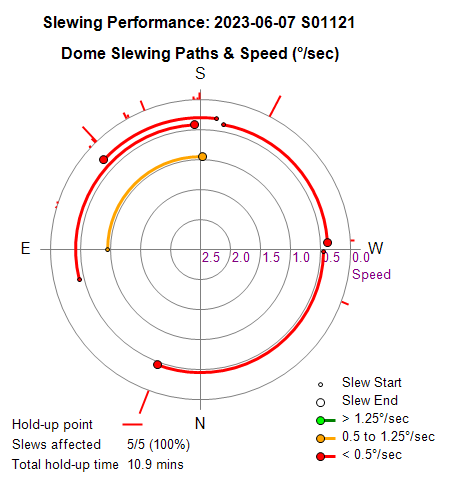
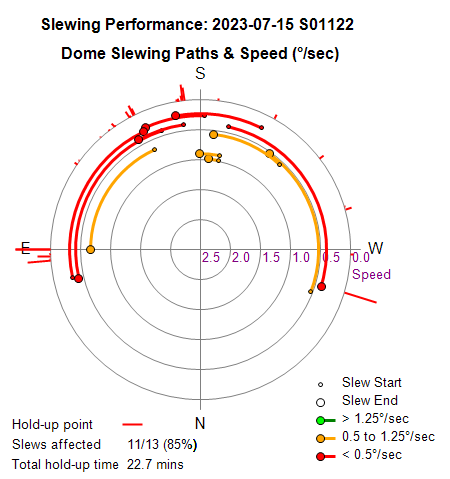
Following S1122 session an intervention was made to tighten the tension of the dome rotation drive system (see Pulsar Dome - Rotation Drive Tension Adjustment, 2023-07-19). Initially the adjustment appeared to have resolved the issue, the chart below shows that the following session (S1123, 2023-07-22) had very good slewing performance, with none of the 13 dome slews being affected by any hold-ups, however the next session (S1124, 2023-07-30) again had 2 slews that were affected by significant hold-ups, costing a total of 4.1 minutes.
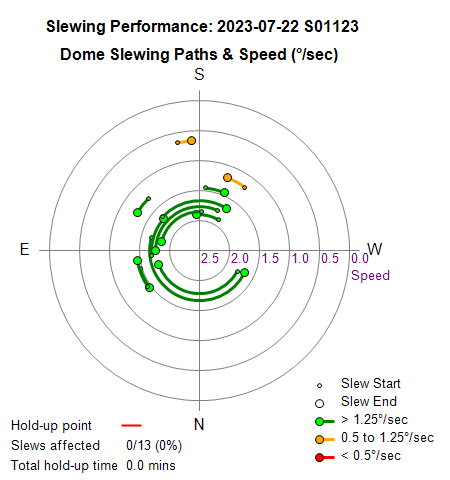
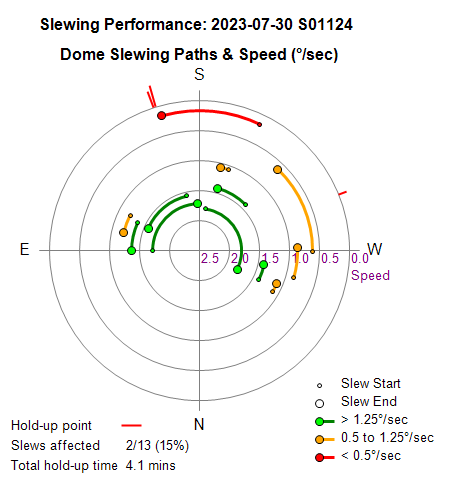
Following further degradation in dome slewing performance in Sep-Oct a new tool was developed following the S1157 session (2023-10-16) that could replay the same dome slews that were made during a session, but under potentially difference test scenarios. The following chart shows the slewing performance during S1157 session (2023-10-16) itself. This can be compared with performance during a playback of the S1157 session slews (see below rightt) made on 2023-10-22 (daytime). This was after the dome's roof flange and its 3 rotation drive wheels had been dried of condensation and moisture and results show that the dome was clearly performing better during the replay (dry state) than during the original live session (presumed damp/wet state)
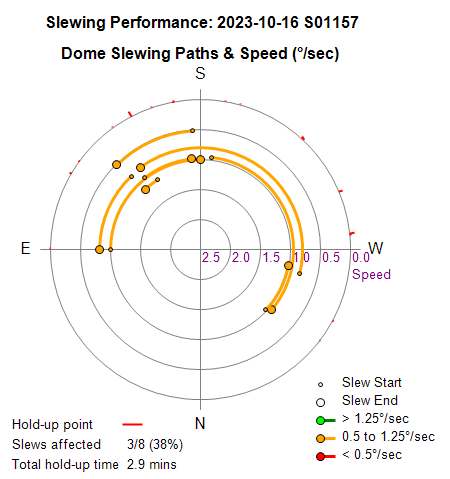
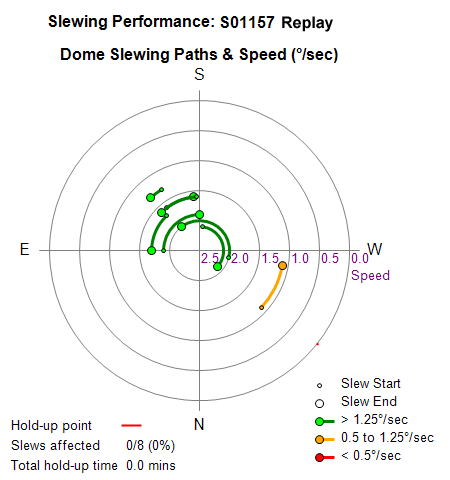
A
second replay of the S1157 slew was attempted on 2023-10-26 (~ 23:30)
(see below right). This was conducted without any prior drying of the
roof flange & drive wheels. This time 4 out of 8 slews failed due to the
dome monitor not receiving a Slewing = True state from the dome within
8s of the 'SlewToAzimuth' instruction (this is presumed to be due to the
dome being held-up at the starting point for the slew). Out of the slews
that proceeded, 3 of the 4 slews encountered significant hold-ups.
(overall we can say 7 / 8 slews had significant holdups). The dome was
performing worse than during the original live session.
A third
play was made on 2023-10-27. This was conducted during daytime
with the dome and its roof flange is a dry state. Slew performance was
good. These 3 playbacks reveal how dome slewing performance is heavily
dependant on the state (dry or damp/wet) of the roof flange & drive
wheels.


Following the initial S1157 replay during which the dome slewing performance was
good, a new live session (S1158, 2023-10-22) was conducted. The initial
slewing (i.e the first 3 slews, corresponding to 3 green arcs in the picture below) was good with no hold-ups but during the
remainder of the session the majority of the dome slews were affected by
significant hold-ups (62% of slews overall), with individual slews being held
up for total of 34-226s (in fact there were 9 slews held up for more than 2
minutes). A total of 45 minutes were lost to hold-ups across the whole
session.
A particular feature highlighted in this session is that
hold-ups points indicated by red spokes in the picture below is
distributed pretty much the whole way around the dome. (Note the azimuth
between

The Observatory Dome is suspected to have a tendancy to hold-up as the dome wall is not
perfectly circular but is very slightly elliptical (this is due to a vital
check being missed during erection of the observatory which is difficult to
rectify now as the dome is securely bolted to its concrete base). This
slight ellipticity causes the dome roof flange to be distorted as it passes
over the wheels in the roof wall and can cause some 'semi-permanent
distortion of the certain parts of the roof flange because of the long
periods of time that the dome sits at its park position. The distortion
leads to varying amount of tension between the drive wheels and the roof
flange, and when the tension/friction is not great enough the wheels can
spin on the same spot for up to 180-240s. Hold-ups (if any) are likely
to be shorter and/or fewer when the dome flange/drive wheels are dry. There is sometimes a correspondance
between the problem nights and nights with higher dew levels, and
tricks of wiping the roof flange from traces of grease, water & dirt
can be sometimes be used to improve dome slewing performance. Taking out
some of the distortion in the roof flange can be relieved by prior manual
manipulation of the flange. Attempting to tighten the
drive tension knob generally fails to improve the situation, as the knob is
pretty much as tight as it can go.
Pictures showing the roof flange are shown below. The left hand picture shows a normal section of the flange whilst the right hand section shows distortion over a particular wheel when the dome is parked.
History
There have been incidents of slow dome slewing or failure to
slew/park going back over 4 years. For example this note from Session 688
(2019-09-01) in Sept 2019
Upon attempting to park the dome at 05:30 in the morning and after the Dome had been stationary for more than 2.1/2 hours, it was found the rotation motors wheels were unable to get sufficient leverage to physically rotate/drive the Dome Roof. The motor wheels would slip against the roof flange which was quite wet with dew by this time. The tension wheels had to be adjusted in order for the wheels to get sufficient grip and move the dome.
The dome was noted to taken a long time (372s or 6.2 minutes) for it to to park at the end of another recent session (2019-08-28, S686)
The Rotation Drive Tension was last adjusted on 2023-07-19, when included getting acces to the nut attaching the drive tension bolt to the metal plate that holds the single drive motor that turns the drive wheel against the inside of the roof flange, there was no mention or recollection that the drive wheel was loose or that there were any aluminum filings/shavings. It is presumed that it was simply a case of them being unoticed since it is hard to imagine that the wheel was securely attached to the drive at this time and that there were no metal shavings.
The following photo shows the rotation drive system before its installation in the observatory in 2018. The two rear wheels are for driving the back of the dome's roof flange whilst the single front wheel is for driving the front of the roof flange.
Analysis
It is clear that at the times of a dome hold-up
that
At the time when the dome is held-up the force being applied to the roof flange is insufficient to overcoming the roof's weight and the frictional forces that otherwise keep the dome roof stationary. Dome hold-ups may be due to one or more of the following fundamental changes.
a) an increase in the frictional forces that tend to
make the dome stationary
b) a reduction in force that drive wheels are
able to intrinsically apply
c) a decrease in the the friction between
drive wheels and roof flange (and thus a reduction in the force that drive
wheels actually impart on the roof flange)
There is no evidence suggesting that the force that the drive wheels can intrinsically exert is changing during an individual slew, or changing between slews or between sessions. (Whilst there was no evidence at the time of this analysis, later on it was discovered that the inner drive wheel wheel, norminally hidden, was loose and wobbled on its motor shaft (see Pulsar Dome - Loose Rotation Drive Wheel, 2023-10-27). This must be limiting the force that this motor can apply to the roof flange)
Potential responsible factors
The potential factors that could
be at least partially responsible for the hold-ups are as follows :-
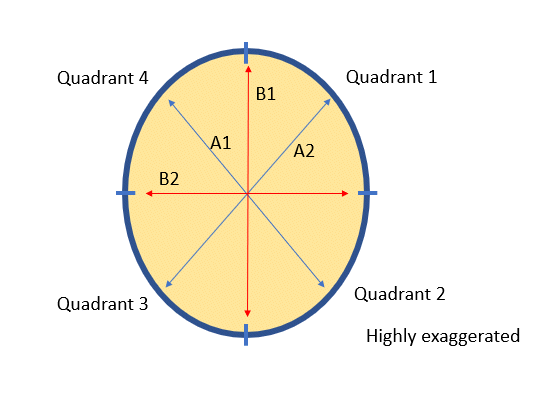
After consideration it is judged that changes such as a) increasing the tension in the rotation drive system, b) retrospectively improving the geometry of the dome or c) closing the dome during slewing have either been tried already (a), are difficult or not feasible (b) or are unlikely to provide the amount of improvement needed (c).
To resolve the dome slewing issue, or to at least significantally
moderate it, the most important action is to increase the grip
between rotation drive wheels and the roof flange (by either
removing water/condensation lubricant or nullifying its impact)
Potential Solutions
Potential
solutions
to removing condensation/dew from the roof flange are:
Potential solutions to nullify the impact of condensation/dew
Most Promising Solution
The most
promising of these potential solutions is judged to be the application of
anti-slip tape to the dome's roof flange.
Conclusion
Actions
Update 2023-10-27
The reel of Anti-Slip Tape has now been
collected from Screwfix (2023-10-26) and successfully applied to the dome's roof
flange today (2023-10-27). It was relatively easy to attach and it seems pretty
secure (see secton below Anti-Slip Tape for
Improving Observatory Dome Rotation, 2023-10-27). The length of tape
required to go completely around the dome flange was 6.18 m, which was shorter
than the possible 6.9m length estimated based on the Dome's 2.2m diameter.
Afterwards, in the course of making checks to see if an adjustment to the rotation drive tension was needed, which involves removal of the wall side half of the induction charger that normally hides the inner motor drive, it was noticed that the drive wheel was loose and there where indications of aluminum filings in the vicinity of the motor drive (See Pulsar Dome - Loose Rotation Drive Wheel, 2023-10-27). Investigation showed that the inner drive wheel, and the associated aluminium cylinder that it screwed to it, was only loosely attached to the motor's drive shaft and had a tendancy to wobble when the motor turned. Wear to the hole in the bottom of the aluminium cylinder and aluminium filings point to a probabe extended period of damage and wear due to the loose fit. This is clearly another (previously unknown) factor in explaining why the drive system's grip on the roof flange is at times insufficient to rotate the dome.
Back to Top
The observatory has had an ongoing issue (2019 to 2023) whereby during some
sessions the dome will experience poor slewing performance with some slews being
held up whilst the rotation drive wheels spin on the same spot on the dome's
roof flange without moving the dome. Typically the drive wheels gradually
nudge forward to they eventually grip and the
rotation continues but they can in some cases be a hold-up of up to 120-180s. The issue has been recently investigated (see
Investigation - Hold-ups during
Dome Slewing, 2023-10-25). The study & analysis concluded that
Condensation/Dew, acting as a lubricant, reduces the force that the rotation
drive motors can apply to the roof flange and is the number factor
responsible for the significant hold-ups but is in part due also the the
domes' 'not-perfectly circular' geometry The investigation went on to
propose the application of Anti-Slip Tape to the inner surface of the
roof flange to increase the grip from the innermost drive motor wheel.
Whilst the root cause to slewing performance issues was
eventually found and fixed, and the Anti-Slip Tape was eventually removed
due to later issues the following description regarding the tape is left as
a record.
Tape
A source of Anti-Slip Tape (18m x 50 mm) was found
at Screwfix and ordered (2023-10-25).
https://www.screwfix.com/p/anti-slip-tape-black-18m-x-50mm/57217
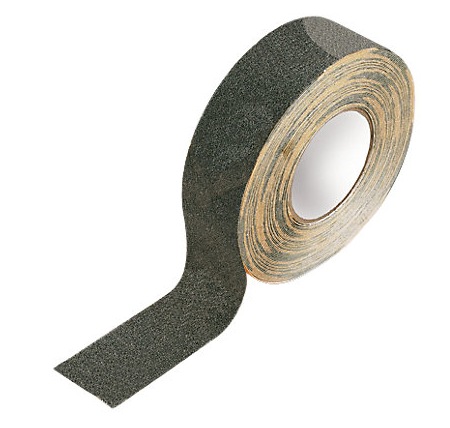
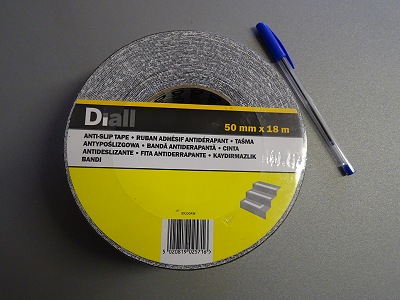
The tape is meant to be
- anti-slip
- easy to apply
- for
Internal & External Use
- self-adhesive
- durable
- at 18m long it is more than long enough to go around the roof flange's
6.9m circumference.
- at 50 mm wide tape is wider than necessary (the
drive wheels are only 20mm wide or so), but it will be difficult to cut it
down to a narrower width and in any case the wider width might allow the
tape to stick to the roof flange more securely.
Collection
The tape was collected
today (2023-10-26).
Checking (2023-10-26 pm) confirms that the roof flange can just about
accomodate the 50mm width tape ok
Installation Plan
The tape will be applied principally to the inner surface of the
roof flange
Fitting to the outer (hidden) surface of roof flange around the whole circumference of the dome would be be very difficult due to limited space between roof flange and the observatory wall with the tape being difficult to control as it will be prone to sticking to the first surface it touches. Despite this an attempt will be made to apply a short section of tape on at least the outside of the flange along the section that lies in the vicinity of the rotation drive when the dome is at it's Park azimuth (90 deg). This woud help allow the dome to moved off it's Park position when commencing a new session, and not hold up any time passing the point when the dome spends most of its time whilst parked and the forces to rotate are notionally at their highest.
Longer term there is uncertainty over how well the tape adheres to the roof flange and whether it separates in future or it stays in place.
Installation
The anti-slip tape has
been successfully applied to the dome's roof flange today (2023-10-27). It
was relatively easy to attach and it seems pretty secure. The length of tape
required to go completely around the dome flange was 6.18 m, which was
shorter than the possible 6.9m length estimated based on the Dome's 2.2m
diameter.
In the course of a make an adjustment to the Dome's Rotation Drive tension, which involves removal of the wall side half of the induction charger that normally hides the inner motor drive, it was noticed that the inner drive wheel was loose and there where indications of aluminum filings in the vicinity of the motor drive (see Pulsar Dome - Loose Rotation Drive Wheel, 2023-10-27). Investigation, showed that the inner drive wheel, and the associated aluminium cylinder that it bolts to, was only loosely attached to the motor's drive shaft and had a tendancy to wobble when the motor turned. Wear to the hole in the bottom of the aluminium cyclinder and aluminium filings point to a probabe extended period of damage and wear due to the loose fit. This is clearly another (previously unknown) factor in explaining why the drive system's grip on the roof flange is at times insufficient to rotate the dome.
Pictures showing the roof flange before and after applying the anti-slip
tape are shown below.
| Roof Flange (Before) | Roof Flange (After) Showing flange after application of Anti-Slip Tape |
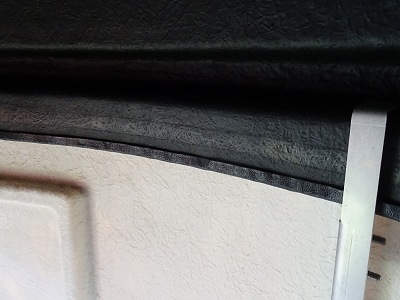 |
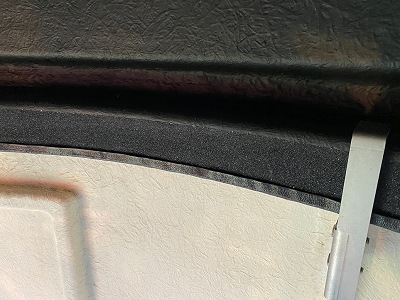 |
Consideration will be given to attempt to apply tape to the outermost
(hidden) side of the roof flange. Whilst the tape was easy to apply to the
inner (accessible) side of the flange, appying the tape to the other side
will be a lot more difficult. However the outermost side is naturally
smoother and prone to be more slippery that innermost surface was. The Dome slewing
performance after fixing the loose rotation drive wheel will also need to be
factored in.
Update 2023-11-17
Although the
primary cause of hold-ups during dome slewing was ultimately found to be due
to a loose drive wheel connector which was replaced today (2023-11-17), the
anti-slip tape will be kept in place and it is thought to be an extra aid to
ensuring smooth rotation of the dome.
It was however noticed that the
anti-slip tape is coming away from the roof flange in a number of places.
These places were mainly at and around the joins between the 4 roof
quadrants where the either side of the roof flange flexes as it passes
across the 8 horizontal wheels at the top of the observatory wall that keep
the dome roof centralised as it rotates. Loose areas of tape where
stuck down with glue and held in place for 3 hours with clamps.
Back to Top
The Dome's Rotation Drive tension was checked following the installation of Anti-Slip Tape in case it needed to be adjusted to allow for the thickness of tape. This involved the removal of the half of the induction charger that sits about the Dome's rotation drive unit and normally hides the inner motor drive. When this was down it was immediately noticed that the drive wheel was loose and there were indications of aluminum filings in the vicinity of the motor drive.
Photos and description follow :
The Dome's Rotation Drive tension was checked today and adjust to allow for the earlier attachment of Ant-Slew Tap to the roof flange. After removal of the half of the induction charger that is attached about the rotation unit , that normally hides the inner motor drive, I came across the problem.
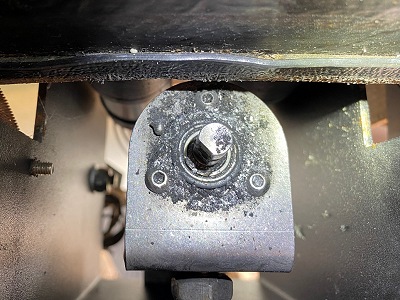
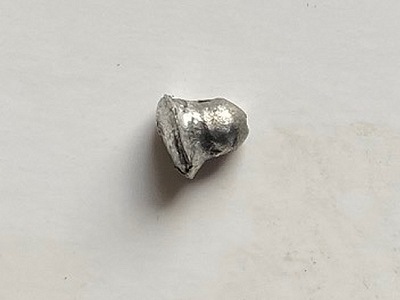
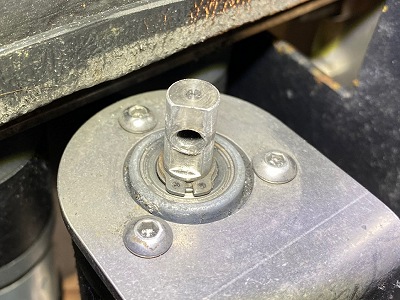

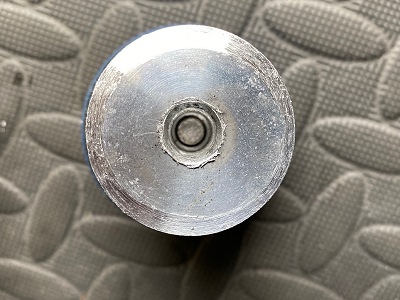
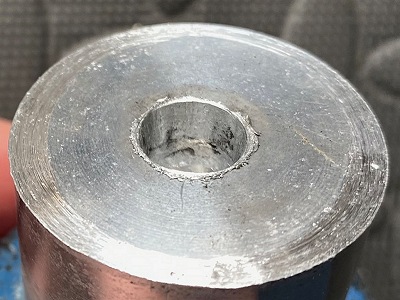
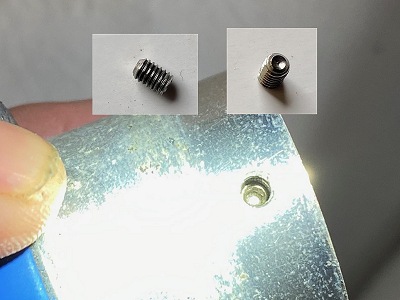
Loosely fitting the wheel/cylinder back on the drive motor again and doing some try slews shows the system is partially working but is still very prone to hold-ups where the dome stops turning for 5-30s before resuming again. It seems the 2 outermost motors are driving the roof and rotation is transferred to the single wheel on the inner side and can cause the shaft to spin away within the 'failed' connector. With the wheel flopping around on the shaft its difficult to get a tension that works (ie one that is not too slack and too tight).
This is clearly another (previously unknown) factor in explaining why the drive system's grip on the roof flange is at times insufficient to rotate the dome.
Previous History
This drive wheel was previously noted to be loose in Jan 2019 (see notes Pulsar Dome - Loose Drive Motor Head, 2019-01-18)
"whilst the replacing the encoder arm
spring on the rotation drive unit it was noticed that head of one of the
rotation driver motors was somewhat loose and its grub screw was partially
unscrewed/loose. Opportunity was taken to tighten the grub screw and ensure
that the motor head was secure. It was fortunate that the problem was
caught before it caused a complication during observatory operation".
2019-01-18.
|
Close Up of Drive Motor Head Photo : 2019-01-18 showing the grub screw that was loose (picture taken after grub screw was tightened) |
 |
Problem of slow dome slewing/slippage noted & investigated in Sep 2019 (see Investigation - Dome Drive Slippage, Slow Slewing & Park Dome Failures, 2019-09-01)
Given that it has been shown during the current (Oct 2023) instance of the problem that the grub screw cannot possibly lock onto the motor's drive shaft, it can be assumed that the observatory has been running with this drive wheel being loose for over 4 years. This extended period can certainly explain the significant wear on the drive wheel connector and the amount of aluminium filings since 2019.
Actions:
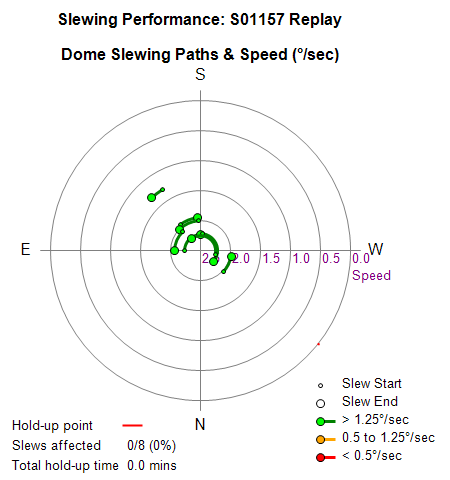
Update 2023-11-08
Whilst the bush-fix to drive
wheel connector has held up well during sessions S1159 - S1162 (e.g. see
below left) , the dome slewing issues suddenly returned during the second
part of the S1163 Session (2023-11-08, see below right).
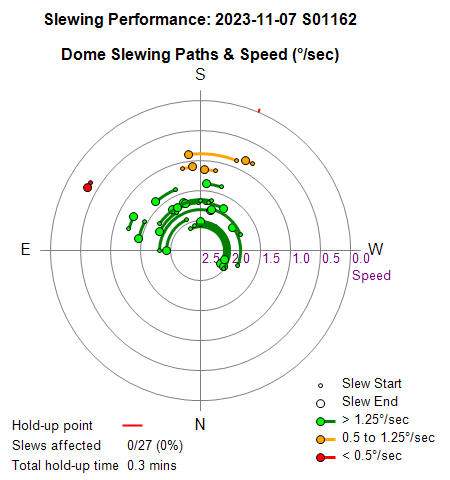

Update 2023-11-09
A check the following morning
(2023-11-09) showed that the metal 'pin' that has been used in the bush fix
had pushed itself out through the holding tape allowing the drive wheel to
again spin on the motor's drive shaft. The pin was re-positioned, re-taped and
the drive tension re-tightened. Tests show that drive motors are
gripping and turning the dome ok.
The repaired bush-fix was operating during the S1164 Session (2023-11-09) and the Dome Slewing Performance
appears to be good.
Update 2023-11-08
Whilst the bush-fix to drive
wheel connector has held up well during session S1164 slewing performance
again suddenly degraded part way through session S1165 (2023-11-10) for
Target 7/36 to Target 9/36 taking 217-240s and in some cases not reaching
the target. Issue was noticed during remote monitoring and after halting
the dome slews and halting the session a visit was made to the observatory
in order to re-fix the loose drive wheel, which is now known to be principal
cause of poor slewing performance. Exposing the drive wheel showed that the
earlier bush fix on 2023-11-09 had failed. After re-fixing the issue the
session was re-continued.
The repaired bush-fix was operating ok
during the remainder of the S1165 session and the during the S1166 session
(2023-11-12). Full resolution of the issue requires installation of a
replacement drive wheel connector but this is still waiting on a delivery
from Pulsar Observatories.
Update 2023-11-15
Repaired bush-fix failed again part
way through session S1167 and once noticed with the dome stuck on Az 222°
the session was prematurely ended as it was too late and too cold to go out
to redo the bush-fix.
Update 2023-11-17
Replacement Drive Wheel and
Connector eventually arrived from Pulsar Observatories this morning and was
successfully installed in the Observatory.
(See
Pulsar Dome - Replacement Rotation Drive Wheel, 2023-11-17 )
Back to Top
Issue: Dome Relay Protection stopped working
(2023-22-07 14:52).
The observatory's Dome Relay feed's
directly to the Dome's Controller Unit. The relay is meant to provide
'fail-safe' protection for the observatory that will directly command the
dome's shutter to close 30s after the observatory's CloudSensor (rain,
clarity & light) changes from 'Safe' to 'Unsafe' state. This is
a third-level protection that is is intended to kick-in in the event that
AstroMain and AstroGuard have both failed to close the Shutter for any
reason such as a program crash or communication failure.
The issue arose because the Dome Replay began indicating a 'Safe' state over a protracted period, whilst Cloud Sensor was indicating an 'Unsafe' state, meaning that the Dome Relay would no longer have closed the Shutter in the event that it began raining or snowing casuing damage to the observatory and equipment.
Description
Whilst demonstrating the observatory prior
to session S1187, 2023-10, the dome' shutter was opened using DeviceHub
(AstroMain wouldn't allow opening due to 'critical light conditions')
at 17:57:20 with the expectation that the CloudSensor to Dome relay would
kick-in and the Dome's Drive unit would command the Shutter to close 30s
later, but it didn't automatically close and was closed instead by a manual
command from DeviceHub at 18:01:34.
The ObsPic shows that the Dome Relay setting (obtained from the active Pulsar Log file) was indicating 'Safe Conditions' even though the Cloud Sensor was reporting Light value of 27 which is critical and would have had the relay in an 'Unsafe' state. Investigating ObsPics for earlier in the day shows that Pulsar Dome was correcting seeing an 'Unsafe' relay state up until 14:52 when it started to see an apparently 'Safe' relay state. This corresponded to a time when Observatory was being visited and the Observatory door was briefly opened for 8s. It isn't known (from memory or log records) what activity was conducted at this time.
ObsPic pictures the following morning show that Pulsar Dome was still showing a 'Safe' Relay indicating that the S1158 session was running without a working Dome Replay Protection (3rd level protection) and is why this issue is ranked as a 'Major Issue' . The Pulsar Dome continued reporting a Safe Relay condition until 2023-10-24 19:18. Records to not show an activity on the Observatory Computer that might explain this change at 19:18, so is the something that happens on the AllSky/Weather Computer ?
Pulsar Dome was similarly reporting a 'Safe Relay' on the
morning of 2023-10-27 even though light conditions were critical (daytime)
and this lasted until 11:26 when it changed to reporting an 'Unsafe' Relay
state. Records show that AstroMain program was closed at 19:51 and
reopened at 10:53 including Starting Dome Service and the opening of new
Pulsar Log File (ASCOM.Pulsar_Observatories_Dome.1054.118990.txt) but Pulsar
Dome continued reporting Safe Replay until 11:12 (At 10:54 Dome Service was
started . At 11:04 was opened and a Test Session was commenced at 11:12 in
order to Replay Dome Slews from the earlier S1157 session.
At this same time (11:12) and until 11:20 the ObsPics still show the Pulsar
Dome reporting a 'Safe' relay despite critical daylight and cloud
conditions. At 11:21 clarity falls below 20 and the relay changes to
an 'Unsafe' state, before changing back to 'Safe' for a few momenets and
then back to Unsafe again at 11:39. The Relay seems to be responding to
'Clarity' though there is a delay between Pulsar data and Cloud Sensor
reporting (or vice versa ) but not to 'Light' ? Examining CloudSensor's
Sensor Head show that is enabled to set relay to 'Unsafe' when Clarity falls
below 20, Rain rises above 2 or Light rises above 20. Examining CloudSensor
data record for 11:15 (10:15 UT) shows Clarity 17.7 and Light 32.2 that
should, on both counts, have the relay in an 'Unsafe'. However the ObsPic
file and the Pulsar Log file both show the Pulsar Dome interpretating the
Replay as 'Safe' Almost like the Dome is interpreting the
opposite state to that intended by CloudSensor III ?.
Dome.Relay value is read from the 12th field in the 'volatile' records shown
in Pulsar Ascom Logs. 0 indicates 'Safe' or a momentarily glitch, 1 indicates
'Unsafe'.
It is currently showing 1 (Unsafe) at 2023-28-15:0
(daylight + rain + cloud).
On 2023-10-22 the Dome Relay was showing
1 at 14:50 (correct) , but 0 at 14:54 (incorrect as it should be 1 according
to CloudSensor intention) with the change happening at 14:52:44). It was
still showing 0 ('Safe') at 18:01 (incorrect) when the shutter was opened
and didn't automatically close as expected based on the Cloud Sensor's Light
value (27).
The Dome Relay settings (see screen capture below (captured 2023-10-28) ) were checked in the Pulsar Dome Program on 2023-10-28 and are confirmed to be correct. Note that 'Polarity' is set to the 'NO' option for it to get the replay state intended by the observatory's CloudSensor (This is to get around the observation that CloudSensor and Pulsar Dome use opposite terminologies for open & closed).

Analysis
Questions to be answered are:
Conclusion
Actions
Back to Top
| This Web Page: | Notes - Session 1158 (2023-10-22) |
| Last Updated : | 2024-03-25 |
| Site Owner : | David Richards |
| Home Page : | David's Astronomy Web Site |